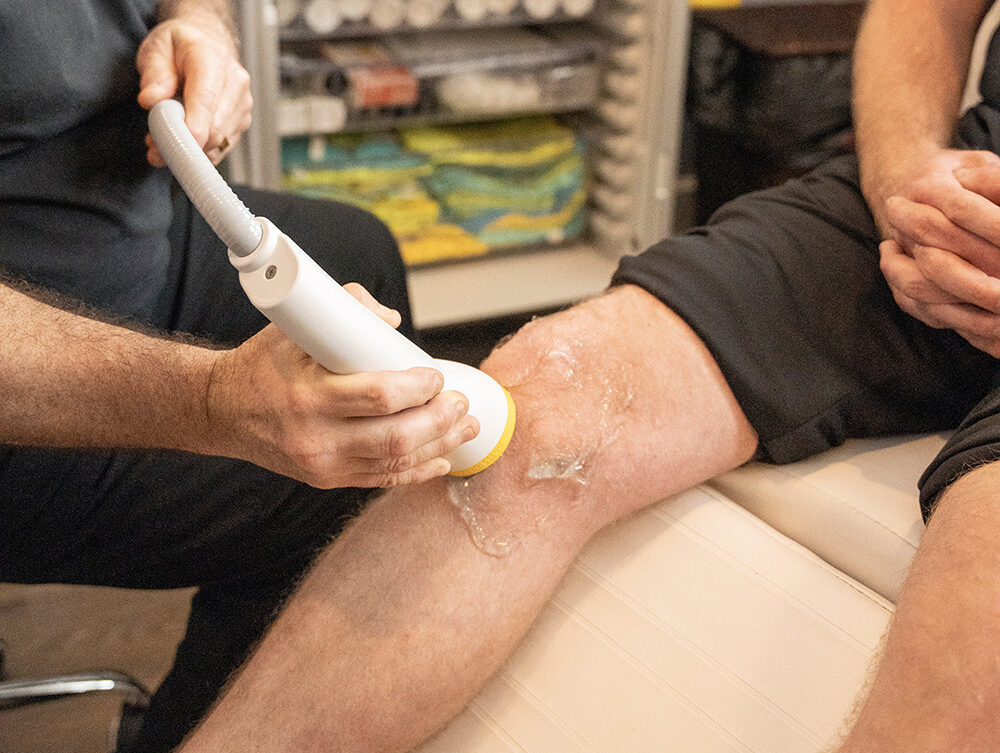Laser treatment for knee pain is a non-invasive therapy that uses specific wavelengths of light to reduce inflammation, alleviate pain, and promote healing in knee tissues. In this article, we’ll discuss the costs, potential side effects, and alternatives to laser treatment, providing you with a comprehensive understanding to help guide your decision.
How Laser Treatment for Knee Pain Works

Laser therapy uses focused light to target and penetrate the tissues of the knee. This light energy is absorbed by the cells, which helps to stimulate various biological processes that reduce inflammation and promote healing. Here’s how it works:
- Reducing Inflammation: Light energy lowers the production of pro-inflammatory chemicals, decreasing swelling and inflammation, alleviating pain, and improving mobility.
- Promoting Cellular Repair: Laser light boosts cellular metabolism and ATP production, enhancing cell repair and regeneration, thus speeding up the healing of damaged tissues.
- Improving Blood Flow: The therapy improves blood circulation, delivering more oxygen and nutrients to the tissues, aiding the healing process, and reducing pain.
There are two main types of lasers used in this therapy:
- Low-Level Laser Therapy (LLLT): This type uses low-intensity lasers to gently stimulate cellular activity. It’s typically recommended for mild to moderate knee pain and works by accelerating the natural healing process at a cellular level.
- High-Intensity Laser Therapy (HILT): This type uses higher-intensity lasers to penetrate deeper into the tissues. It can provide more substantial pain relief and has a stronger anti-inflammatory effect, making it suitable for more severe knee pain.
Laser treatments aim to improve blood flow, enhance tissue repair, and reduce pain and inflammation in the knee, providing a non-invasive option for pain management and recovery.
New Patient Special
Try SoftWave for just $69 at a clinic near you. No drugs. No surgery. Just relief.

Cost of Laser Treatment for Knee Pain
The cost of laser treatment can vary depending on several factors. On average, a single session might cost between $150 and $500. Here are some key points to consider:
- Type of Laser: Low-Level Laser Therapy (LLLT) sessions typically cost between $150 and $300 per session. High-Intensity Laser Therapy (HILT) sessions tend to be more expensive, ranging from $300 to $600 per session.
- Number of Sessions: The number of sessions required can range from as few as 5-6 sessions to as many as 30 sessions, depending on the severity of the knee pain and the specific treatment plan. This means the overall cost can vary significantly.
- Geographic Location: Treatment costs can vary based on the region and clinic. Urban areas with higher living costs may charge more for these treatments compared to rural areas.
On average, a single session of laser treatment might cost between $150 and $600. Given the wide range of sessions needed, a complete treatment course can range from $750 to $18,000, depending on the number of sessions and type of laser used.
Insurance coverage for laser treatment varies. While some plans may cover a portion of the cost if the treatment is deemed medically necessary, many patients might need to pay some expenses out of pocket. It is crucial to check with your insurance provider to understand your specific coverage.
Potential Side Effects of Laser Treatment for Knee Pain
Like any medical treatment, laser therapy comes with potential side effects. Common side effects are usually mild and include temporary discomfort, redness, or swelling at the treatment site. These symptoms typically resolve on their own within a few hours to a few days.
Rare but serious side effects can occur if the treatment is not performed correctly. These might include burns or skin damage. To minimize risks, it’s crucial to choose a qualified professional who is experienced in laser therapy.
Alternatives to Laser Treatment for Knee Pain
If laser therapy isn’t the right fit for you, there are several other treatments available to manage knee pain. These alternatives range from conventional methods to innovative therapies that provide various benefits.
Physical Therapy
Physical therapy is a highly effective way to manage knee pain. Through targeted exercises and manual therapies, physical therapists help strengthen the muscles around the knee, improve flexibility, and enhance overall joint function. This approach not only alleviates pain but also prevents future injuries by promoting better knee stability and movement.
Medication and Injections
For those seeking relief from knee pain, medications such as nonsteroidal anti-inflammatory drugs (NSAIDs) can reduce inflammation and discomfort. In addition to oral medications, corticosteroid injections can provide significant pain relief by reducing inflammation directly in the affected area. Hyaluronic acid injections are another option, working as a lubricant to ease joint movement and reduce pain.
Surgery
In severe cases of knee pain, surgical options might be necessary. Arthroscopy is a minimally invasive surgery that allows doctors to diagnose and treat joint problems. For more advanced issues, knee replacement surgery might be recommended. This procedure involves replacing the damaged parts of the knee with artificial components, providing long-term relief and improved function.
SoftWave Therapy
SoftWave therapy is an innovative treatment that uses broad-focused shockwaves to stimulate healing and reduce knee pain. This non-invasive therapy promotes tissue regeneration and improves blood circulation in the affected area. SoftWave is clinically proven with a 65% to 91% improvement with musculoskeletal and general pain complaints. Additionally, SoftWave therapy is effective for a broader range of conditions and has minimal side effects, making it a promising alternative for many patients.
Acupuncture
Acupuncture is a traditional Chinese medicine practice that involves inserting thin needles into specific points on the body. This technique helps relieve knee pain by targeting areas associated with pain and inflammation. Many patients find acupuncture effective in reducing discomfort and improving joint function, making it a viable option for those looking for alternative pain relief methods.
Platelet-Rich Plasma (PRP) Therapy
PRP therapy uses a patient’s own blood to promote healing in the knee. The process involves drawing a small amount of blood, processing it to concentrate the platelets, and then injecting the PRP into the knee joint. The growth factors in the platelets help reduce inflammation and promote tissue repair, providing relief from pain and improving joint function.
Weight Management and Exercise
Maintaining a healthy weight and engaging in regular exercise are crucial for managing knee pain. Excess weight puts additional stress on the knee joints, exacerbating pain and discomfort. Low-impact exercises, such as swimming, cycling, and walking, can strengthen the muscles around the knee, improve flexibility, and reduce pain. Incorporating these activities into your routine can significantly enhance knee health and overall well-being.
How To Choose the Right Treatment for Your Knee Pain?

Choosing the right treatment for knee pain involves considering several factors and consulting with healthcare professionals. Here’s a checklist to help guide your decision:
- Severity of Pain: Assess how severe your pain is and how it impacts your daily life.
- Lifestyle: Consider how different treatments will fit into your lifestyle and daily routine.
- Personal Preferences: Think about your comfort level with various treatments, such as injections or surgery.
- Medical History: Discuss any previous treatments or surgeries with your healthcare provider.
- Professional Advice: Always consult with healthcare professionals to get an expert opinion on the best treatment options for your specific condition.
By carefully evaluating these factors and seeking professional guidance, you can make an informed decision and find the most suitable treatment to alleviate your knee pain.
The Best Shockwave Therapy for Knee Pain
Are you looking for safe, reliable, and effective relief from knee pain?
SoftWave therapy is FDA-cleared, patented, and nationally recognized for its leading tissue regeneration technology. Unlike other types of high-energy shockwave treatments, SoftWave is the only shockwave therapy on the market that uses true broad-focused shock waves that treat larger and deeper areas of tissue.
Thousands of patients have experienced the benefits of SoftWave for plantar fasciitis, including:
- Little to no side effects
- Short treatment time
- Quick recovery
- Long-lasting results
Find a SoftWave Therapy provider near you or learn more about SoftWave and whether or not you’re eligible for full treatment today!
New Patient Special
Try SoftWave for just $69 at a clinic near you and learn if you’re a candidate for full treatment





